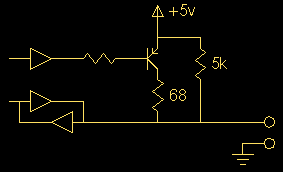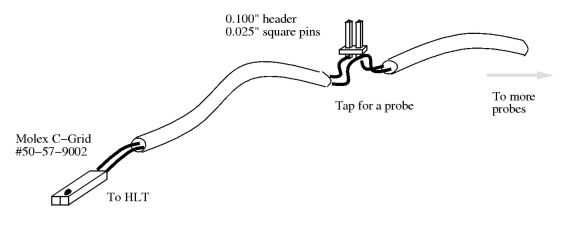
Hot Little Therm FAQ
Updated 01 November 1997
Q: What machines will Hot Little Therm work with?
A: It will connect to anything that can send and receive 1200 baud ASCII RS-232, and you can get a temperature reading in degrees C directly from the unit.
Host computer software to read the therm and do more with the output is currently available for Unix machines (lots of stuff) and DOS/Windows (a program to display the temperature in a window).
Q: How long are the wires from the Hot Little Therm unit to the probe?
A: We ship the Hot Little Therm with a 14' cable from the computer to the HLT unit, and a 10' cable from the HLT to the probe. So, a probe can be up to 24' from the computer, and probes can be up to 20' apart. You can extend the wires yourself if you need to go longer distances.
Q: Can the wires from the Hot Little Therm unit to the probes be extended, and how long can they be?
A: Yes, the probe wire can be extended. We just ship 10' wires because they're long enough for most applications. There is a limit to the total length of probe cables that can be connected to a single HLT.
Spoiler: A total of up to 300 feet of cable should work fine. If you use too much wire, the HLT won't be able to read to probes correctly. If you have firmware rev. 7.4 or later you'll get "******" because the CRC checksum will be incorrect. Firmware 7.3 and earlier doesn't check the CRC, and the HLT will instead print insane temperatures.
Long Answer: The main concerns with long probe wires or many probes are:
Capacitive loading due to the cable and probes
Reflections from the end(s) of the cable
Resistance of long wires
Noise on long wires
Capacitive Loading
The probe driver circuitry in the HLT looks like this:

Figure 1. Probe bus driver circuitry
When sending data to the probes, the HLT drives the line both high and low, and line capacitance is not very important. When receiving, however, the probes can only pull the line low and must let it float high. To read a bit from a probe, the HLT sends a 4us low pulse and then stops driving the line. The probe may either drive the line low for 30us nominal to send a logic 0, or release it and let it float high to send a logic 1. The HLT samples the line after 15us to determine the bit value. The most critical timing occurs when the probe sends a logic 1 bit. The line must float high through the pullup resistor within 15us to be read correctly.
The line voltage approximately follows that of a capacitor charging through a resistor:
Vc = Vs ( 1 - e-t / rc )
In this case, Vs is the applied voltage (5 volts), Vc is the line voltage, r is the pullup resistor (5k ohms) and c is the total line capacitance.
The capacitance of a single 10' probe (as measured for 10 probes connected in parallel on the bench) is about 130pF, and this is mostly due to the cable itself. If we solve the equation with Vc=2.0 and r=5000 and t=15E-6 we get a maximum allowable capacitance of around 5800pF. This translates to around 45 probes, or 450 feet of wire, e.g. any combination of probe wire lengths up to a total of 450 feet should work. However, 2.0 volts is pretty marginal, since the capacitance is somewhat variable, and can depend on where and how the wire is run. I'd recommend a more conservative limit, say 300 feet. That is, you could have one probe 300 feet away, or 10 at a distance of 30 feet.
Reflections
Reflections from the far end of the probe cable are the second main concern. It is not possible to terminate the cable in its characteristic impedance, due to the open-collector nature of the bus and constraints on the minimum value of the pullup resistor. To obtain the ultimate performance, an active-pullup circuit is recommended for the driver. Hot Little Therm uses a simpler circuit, and limits the slew rate of the negative-going signal (the worst case) with a series resistor. This works well enough for moderate (hundreds of feet) cable lengths.
Other
Two other possible concerns are resistance of the probe wire, and propagation delay. Excessive resistance would cause a voltage drop in the wire between the HLT and probes, causing bad readings. Typical resistance of the ribbon cable used is 0.1 ohm/foot, theoretically allowing thousands of feet of wire before any problems would be encountered. Propagation delay, around 1 ns per foot, should also not be a problem except in very long cables.
A final concern is noise on the probe cables. The standard ribbon wire is fine for short runs, but is susceptible to noise from heavy equipment - radios, etc. For long runs I'd recommend thin-gauge shielded or coax, for example microphone cable. Note that different types of cable have different capacities per foot.
Suggestions
Here are some things you might try when using long probe cables:
It is preferable to daisy-chain the cable from probe to probe in order to conserve wire and reduce reflections from each cable end (see figure 2).
You can reduce the 5k ohm pullup resistance built into the therm board to compensate for capacitive loading. This requires a wiring change on the therm circuit board. The minimum value is 1.5k, so if a resistor is added in parallel, its value must be greater than 2.2k.
Note: This requires modifying the circuit board, and is probably not necessary, so save it for last.
Try putting a 68 ohm resistor in series with the positive lead of the probe cable, at the therm board. This will limit the slew rate of the driven signal, and reduce undershoot and ringing.
Note: Version 9 therms already have a 68 ohm series resistor.
For even more information on this topic, see application note 108 at the Dallas Semiconductor web site here.

Figure 2. Daisy-chain probe wiring
Q: How long can the wire from the computer to the Hot Little Therm unit be?
A: Long. I've personally run 9600 baud cables the better part of a mile and they worked fine. Therm runs at only 1200 baud, so you should have no trouble with 1000 feet of wire. Sorry, I haven't done a more in-depth analysis of this yet.
Just get a huge chunk of phone cable and crimp a modular connector on each end. Be sure to give the cable a half-twist between ends, e.g. pin 1 becomes pin 4 on the other end.
Q: What all comes with the hobbyist version?
A: You get all the same parts that go into the production version, including a precut plastic enclosure. When assembled, you end up with the same thing we ship.
Q: How waterproof are the probes?
A: Well, we coat the sensor in non-acid silicone RTV then cover it with heat-shrink tubing and cure it. So, they're pretty water-resistant. I've had one out my window in the wind and rain for years and have had no trouble. If it really has it to be watertight for continuous exposure, the only real option is to enclose the probe in a glass or stainless steel tube (this is common for immersion probes). Plastics, epoxy, etc. can slowly absorb water if immersed and this may eventually cause the probe to fail or change its calibration (again, they're pretty tough, though).
Q: Why is there a limit of 16 probes on a single Hot Little Therm?
(this applies to Version 7 therms, not Version 9)
A: We wanted to be able to address multiple devices on a serial port with a one-byte command, so we reserved 4 bits for unit number and 4 bits for unit command (probe number). 16 is not a built-in limit for DS1820 probes, it just seemed like a reasonable cut-off point.
Q: Does HLT sample the DS1820 using the high resolution algorithm?
A: Yes, we read the remainder and count registers and do the calculation as described in the data sheet and Dallas app. note 105. HLT then reports the temperature to 0.1C resolution.
Q: Does HLT get power from the serial port?
A: No, we use a small wall transformer to provide power. It's connected to the serial-port adapter that plugs into the computer. The reason we don't steal power from the serial port is that there sometimes isn't enough. Some computers drive the signals barely high enough to work reliably, even when loaded with just a receiver, and increasing the drain could cause flaky operation. Not only that, therms are chainable on the same serial port, and several units would draw more power than we could possibly get from a serial port.
Copyright © 1997-1999 Spiderplant. All Rights Reserved.
therm@spiderplant.com